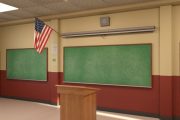
The technology is supposed to make schoolchildren safer — but should parents be concerned about their children’s privacy?
A manufacturer of facial recognition technology has released a guide to help school administrators get the most out of the cameras installed in K-12 classrooms.
RealNetworks provides its facial recognition technology to schools free of charge in order to help make the country’s schools safer. The guide’s release was timed so as to reach school districts during The National School Safety Center’s annual Safe Schools Week, observed this year October 21-27.
The handbook’s has six policy sections: notice, consent, security, retention, transparency, and management. It includes information intended to assuage any potential concerns about privacy, and assures administrators, parents, and teachers that the purported security benefits delivered by the cameras and the facial recognition software they use far outweigh any second thoughts about the children’s rights.
“Facial recognition is a new technology for schools. Parents, teachers, and students have an interest in balancing privacy with security so we wanted to offer an introductory guide for schools to develop policies that meet all their needs,” Mike Vance, senior director of product management at RealNetworks, writes. “Through our early partnerships with schools and school districts we’ve developed this set of key best practices for creating safer and more secure K-12 campuses. This guide delivers that knowledge to the public, for free.”
And, in other big news, the company announced that its software was now compatible with Windows, making it fully functional on Windows, macOS, and iOS. At the end of that product compatibility announcement, RealNetwords reminds readers — again — that its technology is free to schools in the United States and Canada.
The technology is called SAFR (Safe Accurate Facial Recognition), and it is completely compatible with existing IP-based cameras many schools have already installed. Cameras retrofitted with the RealNetworks software will provide real-time recognition and will allow local or cloud storage of the images recorded by the cameras.
RealNetworks’ publicity material promises that the SAFR software will encrypt all the images and will only transmit the images over the internet if the school system chooses to store the data on the cloud.
In this brave new world in which we live, I imagine most school district superintendent or school board bureaucrats will sense nothing eerie in the following paragraph promoting the power of SAFR:
SAFR from RealNetworks is highly accurate facial recognition software powered by artificial intelligence. It works with existing IP cameras and readily available hardware to match faces in real-time. Schools can stay focused and better analyze potential threats such as expelled students, and those who pose a threat from within and outside the school.
You read that right, Mom and Dad. Soon, if your cash-strapped local public school can come up with enough funding to buy surveillance cameras, then RealNetworks will happily send some software that will not only keep the kids under the close eye of administrators, but will also positively identify their faces and upload them to a database for future reference. You know, in case little Johnny ever gets in trouble.
Wondering if such amazing power can be put right on the principal’s laptop? It sure can, citizen! Here’s how it’s done, as explained by the SAFR website:
To deliver best-in-class accuracy and performance, SAFR uses the latest machine learning techniques to detect and differentiate individuals in complex surroundings with proven accuracy of 99.8%. It never stops learning and improving. It supports many cameras and detects multiple faces in each camera feed. Each face can be analyzed and rapidly matched to a database of enrolled faces. SAFR supports numerous secure access use cases where facial recognition can replace the use of an ID badge, securely automate entry to facilities, trigger notifications, and log events for analytics. SAFR works with off-the-shelf IP cameras and runs on mobile devices and readily available computers.
See there? The manufacturer guarantees nearly perfect accuracy in its ability to identify you child’s face and keep it safely stored in a database.
RealNetworks reports that the images recorded and recognized is “password-protected, encrypted, and can only be accessed by a select group of authorized users.”
I ask you, Mom and Dad, what would happen if, despite all the software’s safeguards, the database containing thousands of real-time pictures of children was somehow hacked. The wickedness of this world makes one shudder at the thought.
Not only that, but the software is always on the job, not like a school resource officer or even a regular old camera not equipped with SAFR. SAFR will analyze the faces of students, teachers, and visitors in real time, and it doesn’t have to be updated because this software “never stops learning and improving.”
What a find! Faces captured, cataloged, and collated, and it all costs you nothing!
Nothing except your liberty, of course, but what good is liberty when you can have security instead?
Apparently, there’s not a lot of demand for freedom, but there’s a constant clamor for greater security. As RealNetworks boasts, “Districts nationwide are successfully incorporating this technology as part of daily life in schools.”
Real time surveillance with nearly foolproof facial recognition is “part of daily life in schools.”
Is it any wonder why millions of American parents are opting to keep their children out of these publicly funded Panopticons?
In the last paragraph of the SAFR press kit, RealNetworks reminds potential customers of the “best practices” of those who want to get the most out of their facial recognition technology:
Successful implementation requires thoughtful planning, a good dose of common sense and of course, the selection of a highly accurate facial recognition technology, such as SAFR by RealNetworks. Following the standards detailed above will not only promote a smooth transition for your organization, but also result in a more connected, empowered, and ultimately safer community.
One wonders if the data collected by the school surveillance cameras running the RealNetworks facial recognition software would be afforded any additional legal protection should law enforcement — federal, state, or local — demand that the database be turned over to them.
Then, if the images were seized by police or other law enforcement agents, will there be any constitutionally sound protocol for destroying the data after it is used?
What would become of the recorded images of the scores of children not included in a warrant? Would those images be copied and cataloged by law enforcement and combined with the thousands of other images contained in the various government-controlled databases of faces and other biometric data? Would that then effectively exclude those kids’ faces from the protections put in place by the school district?
One last point needs to be made. RealNetworks, the developer of SAFR, is based in Seattle as is Microsoft. A couple of Microsoft executives sit on the board of directors of RealNetworks. Why does this matter?
RealNetworks is giving away its facial recognition software to schools, and the Bill Gates Foundation has called for there to be cameras in every classroom.
Maybe that’s just a coincidence.
What is no coincidence is the fact that cameras are commonplace in publicly-funded schools (public and charter), and those cameras can be equipped for free with extraordinarily powerful technology that records the faces of the millions of American public-school kids and then recognizes the faces of those young people with near-perfect accuracy, storing them at school or in the cloud indefinitely.
Photo: diego_cervo/iStock/Getty Images Plus




